Keith Glein Problem Solving Blog
This blog provides comments on problem solving and other topics.
Saturday, April 12, 2014
Deconstructing Your Complex Problem

Taking something apart to see how it works, isn't exactly a novel idea. In fact, I'm sure you can think of many times when you've used this method to figure out things.
I think it's a rather intuitive response when it comes to figuring out things. But for some reason, when it comes to figuring out our most complex problems, this is not our natural first instinct. In fact, we may not even recognize that we should be using this method to solve our problems in the first place.
As with a lot of the ideas I present here, when faced with simple problems we just seem go on autopilot and our problems get solved without much heavy thinking. We're seemingly unaware of the truly complex mental processes that are really going on below our level of awareness. That's because these cognitive processes have been so ingrained in our thinking (and they happen so fast) that they appear to be automatic.
But when we're faced with a really difficult problem, we freeze, like some deer that appears in our headlights in the middle of the night. I'll explain why I think this happens to us in a minute. But I can tell you that you should keep using the same methods that have worked for you your whole life ... but with a new twist.
Deliberate Thinking

The key point to contrast here is that when you're solving a really complex problem these cognitive processes are not going to work automatically for you. You're going to have to slow down and deliberately think about how to put these problem solving processes into practice.
When you're solving simple problems, your neurons travel at the speed of light down the same old neural pathways. Over time, these neural pathways have become your dominant way of thinking. They've been burned into your brain to the point where your thinking appears to be automatic.

Now you're faced with a really difficult problem and your automatic thinking just can't handle the complexity of your new problem. Don't give up! Recognize why this is happening to you, then just slow your thinking down a little bit. Take it one-step-at-a-time and deliberately think your way though it.
Hey, I know it's no fun getting out of the fast lane but you may need to slow down your thinking a bit if you're going to take that exit that gets you where you really want to go.
Decomposition Process
Breaking your problem down into it's component parts can be viewed as a three-part process. First, you need to identify all the parts of your problem. Next, you should analyze each part, so you completely understand it's significance (as it relates to your problem). Then, you can use your cognitive skills to develop a logical structure that fits all your parts together into a cohesive whole.
Identifying All Your Factors
First, you need to identify all the parts of your problem. Look at every factor, part, component, feature, attribute, property, trait, quality, aspect, characteristic, facet, issue, subject, element, event, source, cause, effect, and action related to your problem.
I usually start by creating a master list of all the factors. At this point, I'm not too concern with ordering them. I'm just making sure that I write every single one of them down. I'll keep adding to this list as I learn more about my problem.

I like to use the analogy of a puzzle for this initial phase. Before you begin putting a puzzle together, you should make sure you have all the pieces of the puzzle out on the table. You wouldn't want to leave any in the box or leave some pieces on the floor? It's the same idea here. You need to identify all the items that need to be considered in your analysis; before you start analyzing.
Another part of this initial process touches on the concept of scoping your problem. What are the boundaries of your problem? Looking at all of the parts of your problem should help you determine the boundaries.
You need to look at your factors from the viewpoint of completeness, too. Are there any major gaps in your data? Do you see any areas where there's lots of uncertainty? This may help you prioritize the focus of your research and the deployment of your resources.
I also think you should pay particular attention to any unexpected or unusual factors. Be on the lookout for these as you create your list and make sure you take note of them. You'll be glad you did.
You can use my Factors tool to get started identifying all the parts of your problem.
Sorting & Grouping
Sorting may be the most underrated process in problem solving.
Sorting and grouping is where you really begin building your structure. And if I believe in anything, it's that structure is the key to solving problems.
Now, all you need is a system for structuring your problem. That's where sorting and grouping come in. They can help you create different ways for describing your data.
Data does not describe itself. Data needs to be described, then organized to be used efficiently and effectively.
To get help with your sorting efforts, try using my Sorting tool.
Major Categories
The first structural element I use to describe my data are major categories. The idea is pretty simple. You just break your problem down into its major component parts. Your goal here is to identify all of your major categories.

Major categories should be:
- Clearly defined,
- Mutually exclusive, and
- Collectively exhaustive.
Defining your major categories may seem like an easy task but you need to take your time here and think this all the way through. Keep in mind that you must have a place to put all of your data. No extra pieces of data can be left out of your analysis. Especially, those that don't fit neatly into your preconceived view of the world.
Also, remember that your major categories can help determine the scope of your analysis.
Your major categories are the foundation that the rest of your problem-solving structure will be built upon. For complex problems, you may have multiple levels of sub-categories that form a hierarchical structure of your problem.
For help to decompose your problem into its major factors, use our Major Categories tool in our Toolkit section.
Interrogatory Dimensions
Using interrogatory words can be another good way sort and group your factors.

Asking key questions is one of the most important techniques you can use to explore the different dimensions of your problem. It just makes sense that finding the right questions will give you a better understanding of your problem and get you closer to the answers that will eventually solve your problem. As you go through the problem-solving process keep track of your key questions. To help you get started, I've developed several lists of generic questions: Who, What, When, Where, Why, How, From Where, To Where, and the Phoenix Checklist. Review the lists of generic questions and pick out the ones that you consider to be key questions for your situation. Of course, the questions you think of on your own could be the best questions of all.
You can also use interrogatory dimensions to group the answers to your questions. This is an important structuring methodology because it allows you categorize every factor by an interrogatory dimension.
Relationships Between the Parts of Your Problem
Another way to deconstruct your problem is to analyze your data by searching for relationships, looking for comparisons, and creating visual representations.
You can look at dependencies between your data as a way to group your factors. These are typically cause and effect relationships.
In my previous blog post, I discussed how you can use analogies to help you solve your problems. This method can help you compare your data for similarities and differences.

The relationships between your factors are important. Examples of relationships can be seen in: groupings, cause & effect, variable dependencies, sequences, correlations, analogies, and similarities & differences.
A good way to understand your relationships is to create visual representations of your data structure. You can use my Mind Mapping tool to get started.
You're the Most Important Part

I don't know you. But I know you're the most important factor in solving your own problems.
You - the problem solver - are the reason I created this website, write this blog, and rack my brain for ways to empower you to solve your own problems.
You may think my belief in you is just a bunch of hot air. Yeah, there was a time when I didn't believe that I was the main ingredient to solving my own problems, too. It was a time when I was just twisting in the wind. I saw myself as victim of my own circumstances.
Then I took control of that crazy world and brought order to it through problem solving.
I found a better life. A life where I was no longer defined by my problems, but by my ability to solve them.
As a man much wiser than I once wrote:
"You are braver than you believe,"
"You are stronger than you seem, and"
"You are smarter than think."
Les Westrum, RIP 2005 from A.A. Milne (Christopher Robin to Winnie the Pooh)
Sunday, March 30, 2014
Using Analogies to Solve Your Problems

Sometimes when you get stuck trying to solve a problem, all you really need is to have a new pathway open up that will get you pointed in the right direction. But if you're stuck and at a dead end, how do you move forward?
What if I told you that you need to look at another problem?
No, I'm not joking. I realize you probably have enough problems already and aren't looking for any more. But by looking at another problem, especially a problem with many similarities to your situation, you may very well find the key to solving your problem. Please let me elaborate.
Definition of an Analogy
First, let's define an analogy. An analogy transfers information or meaning from a source object to a target object.
For our purposes, the source object is the problem (or thing) that you select that is similar to your problem. The target object is your problem.
Analogies and Structure
These objects may share many types of structural features, such as, factors, effects, patterns, relations, actions, ideas, and language.
Analogies and the Structure of Language
Analogies can best be viewed through a systematic feature of our language that shows an interdependency of words. Examples of this in our language are: compare, similar, like, resemble, associate, exemplify, relationship, metaphor, simile, allegory, and parable. Using language that conveys interdependencies is a time-tested method for understanding problems.
Secrets of the Analogical Process
- Cognitive process of selection - selecting the source object to be used as your analogy, selecting the relevant information in your source and target objects, and selecting how you analyze the shared aspects.
- Perception - of both your source and target objects. Use all of your sense to perceive your problem and your analogy.
- Mental models - that represent both your source and target. Examine and test your mental models regarding both your source and target objects to ensure your preconceived notions are surfaced and understood.
- Analytical process of pattern recognition - to find the shared features of your source and target objects.
- Mapping and alignment - from your source object to your target object. This mapping and alignment can be done between a single individual relationship or between complete domains of knowledge.
- Drawing deductions and conclusions - about the structures of your problem and the problem your comparing it to.
- Apply the underlying logical structure - from your analogy to your problem.
- Interpretations - that lead to minimizing the amount of information needed to solve your analogy.
Make Sure You Use Analogies

Using analogies to solve your problems is a good approach. You may not have spent a lot time thinking about how analogies work, but it's a process that you're already quite familiar with since you've been using analogies for most of your life. It's a time-tested approach that's used extensive in schools.
Any time you face a difficult problem, you should use analogies to solve it. If it doesn't lead directly to a solution, it may lead to new ideas that can serve as a bridge to your eventual solution.
Here are some links to my problem solving tools that use analogies: Analogies, Similarities & Differences, Structured Analogies Matrix, Synectics, Observed & Merged Viewpoints, Metaphors, Excursions, and Role Playing.
Find the Best Analogy
The most important aspect in using analogies is to select the best analogy. Selecting the best analogy provides you an economy effort that makes it easier to find your solution.
Saturday, March 15, 2014

Mental models are our internal representations of reality.
Mental models give each of us our own unique perspective of the world.
Any time you're solving a problem, you're relying heavily on your own mental models. In order to avoid some of the pitfalls in problem solving, you must be aware of the limitations that are inherent in your own mental models.
The Assertions of Mental Models Theory:
- Mental models are psychological representations of real, hypothetical, or imaginary situations.
- Experimental data in cognitive psychology suggest that humans reason and solve problems through the use of internal representations that can be mentally scrutinized and processed.
- Reasoning depends on mental simulations of events through the use of mental models.
- Compared to the complexities of the surrounding world, mental models are very limited.
- Mental models are over-simplifications that are the result of the limitations of our working memory.
- Mental models filter information and this can lead to selective perceptions.
- The greater the number of mental models that a task elicits, the poorer performance is.
- The greater the complexity of individual models, the poorer performance is.
- In multiple mental model problems, reasoners focus on a subset of the possible models. This is often just a single mental model.
- Flaws in our mental models can lead to erroneous conclusions and irrational decisions.
- Mental models usually exist below the level of awareness and are often unexamined and untested.
- As the world changes, the gap widens between our mental models and reality, leading to flawed mental models.
- Unquestioned mental models will remain unchanged unless they are challenged.
- The core task for changing flawed mental models is to bring those mental models to the surface and test them.
- The flaws in mental models may only be recognized when confronted with contradictory information.
- We can transform our mental models by using our reflective skills to reconcile the differences between our mental models and present reality.
- We can improve our ability to solve problems by surfacing, testing, and improving our mental models that are closest to our problem.
Unquestioned Mental Models

There are certainly many ways that your mental models can limit your ability to solve your problems. It's important to recognize that you can be susceptible these limitations and the consequences that come with them.
Once you understand the reasons why your mental models are potentially fallible, it's incumbent upon you to determine how you're going to go about questioning your own thinking.
Because your mental models remain fixed until you question them, you'll need to find an approach that gives you the greatest amount of mental agility and flexibility. It stands to reason that your ultimate success or failure may hinge on your ability and willingness to question your own thinking.
The Surrounding World is Always Changing
Unquestioned mental models can certainly lead to problems given the rapidly changing, highly complex, and uncertain world we live in. The world is changing every day whether you realize it or not. Your thinking needs to change along with it.
Solving your problems may be dependent upon your capacity to challenge and target your own unquestioned mental models. Challenging your own thinking can be a lot less painful if you've been doing it all along. I recommend that you keep your mental models up-to-date by using a growth mindset (verses a fixed mindset). Having a growth mindset of continuous learning is the key to growing your mental models to keep pace with an ever changing world.
Friday, February 28, 2014

Finding answers to your questions is an important part of finding solutions to your problems.
In today's search engine driven society we have unprecedented abilities to search for our answers. However, the step that precedes this searching activity, asking questions, is not given as much attention.
In this blog, I'm going to discuss the ideas, methods, and strategies you can use to formulate and manage your questioning activities.
Our Curiosity
Since the dawn of human development, curiosity has been a hallmark of our species. One only has look into the eyes of a baby to see this. The desire to understand the world around us is hard wired into each human being.
The Language of Questions
Our language is structured to describe different kinds of questions. An example of this is the age-old journalist's list of: who, what, when, where, why, and how. These are referred to as interrogatory words.
Interrogatory words have evolved over time as our language has developed. Unfortunately, sometimes these changes have tended to dumb down the language. Sometimes the current popular usages of our language aren't the most precise.

I found an example of this in the history of interrogatory words. In my early problem solving activities, I kept running into the same issue. The interrogatory word when didn't adequately define some aspects of the time continuum.
'When' was fine for defining data that was closely related to the present state but wasn't very good at defining my root causes or outcomes. This kept happening to me, so I decided to see if I could find a solution to this 'problem'.
When I researched the root words related to questioning, I found two no longer used archaic words, whence and whither.
These words defined just what I was looking but I thought these archaic usages might not work so well for other people. So, I needed to find out if there were any modern usages of whence and whither. It turned that the best modern usages I could find for whence and whither were from where and to where.
Interrogatory Words
Here's my list of interrogatory words:
• Who: People, Groups, Human Aspects
• What: Things, Events, Circumstances
• When: Time, Sequences
• Where: Places, Locations
• Why: Reasons
• How: Methods, Manners, Ways
• From Where: Origins, Sources, Root Causes
• To Where: Destinations, Outcomes, Goals
Key Questions

Asking key questions is one of the most important techniques you can use to explore the different dimensions of your problem. It just makes sense that finding the right questions will give you a better understanding of your problem and get you closer to the answers that will eventually solve your problem. As you go through the problem-solving process keep track of your key questions. To help you get started, I've developed several lists of generic questions: Who, What, When, Where, Why, How, From Where, To Where, and the Phoenix Checklist. Review the lists of generic questions and pick out the ones that you consider to be key questions for your situation. Of course, the questions you think of on your own could be the best questions of all.
Starbursting Tool
Here's a diagram of my Starbursting tool:
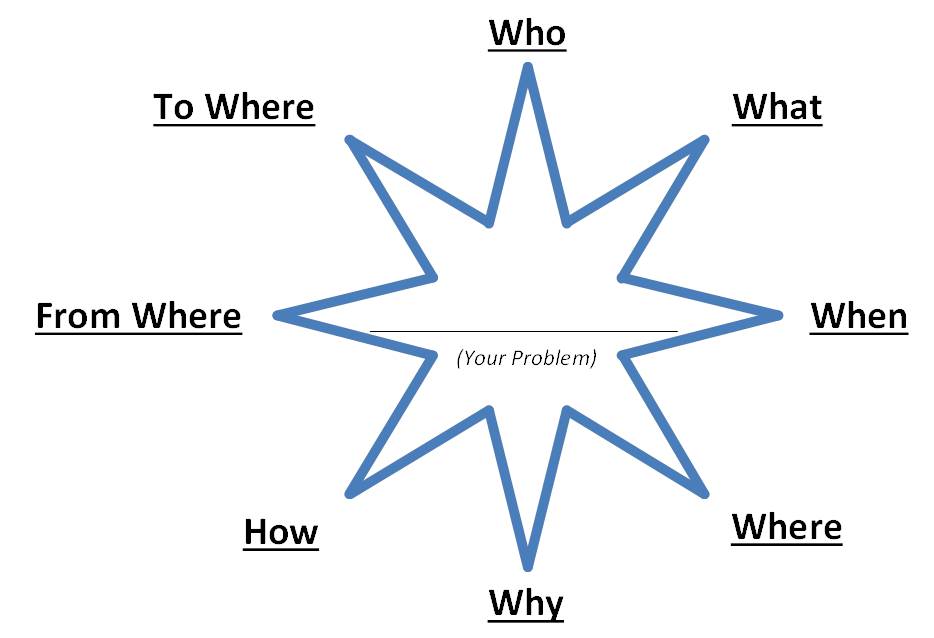
PRINTABLE: PDF version of Starbursting.pdf (Click link to download PDF version).
Completeness of Questioning

To make sure your analysis is complete, you should always ask each one of the eight types of interrogatory questions for each major category of your problem and for each possible solution. In-other-words, this is one of the methods you can use to make sure your analysis is complete.
Interrogatory Questions vs. Interrogatory Dimensions

Interrogatory dimensions are different from interrogatory questions, in that they also include the answers to those questions. Aligning the types of questions (with their corresponding answers) will help you align your thinking.
This is also practical because now you can describe all of your objective data with an interrogatory dimension. This adds an important structural element to your analysis.
Mirroring

Understanding the questions that surround your problem is certainly important to your analysis. But you also need to understand the questions surrounding the other half of the problem solving equation - the questions about your solutions.
There are certain elements in the structure of your problem that will be shared by your solution. One of those structural elements is interrogatory dimensions. As you go thru the problem solving process, keep in mind that there's a 'mirroring effect' between the structure of your problem and the structure of your solution.
The Root of Your Question
As discussed above, interrogatory dimensions describe your data by the root of the underlying question. So, how can this help you?
By using this question-centric focus to you analysis, you can use questioning techniques similar to the age-old 'journalist list' to unleash your natural curiosity. This strategy can also make sure that your analysis is thorough and complete.
Asking the right questions has always been a good way to go about solving problems. As I like to say, "The solution is the thing that happens right after you ask the right question."
Saturday, February 15, 2014

There is one fundamental element in structuring that is common to solving all problems. That element is time.
Time may be the most enigmatic aspect in problem solving. With nearly unlimited quantities of time, almost anything seems possible. When time is short, your options may be very limited. Time may be your most precious resource.
Predicting the Future
In problem solving, there are some aspects of time that are generally not given their proper importance in my humble opinion. Now, I'm not talking about time management here. I think it's well understood that you need to organize your time because you rarely have unlimited amounts of time to solve your problems without suffering consequences.
One concept that I feel is critically important to understand is causality. More specifically, how an action you set in motion today can set off a chain of events that influences future outcomes. In very complex situations, determining outcomes can seem almost impossible to predict. It can also create quite a dilemma for you, since your ultimate goal is to create a future world where your problem no longer exists (i.e. it's already been solved).
Here's a quote that reframes this issue:
"The best way to predict the future is to create it." - Peter Drucker
Time Perspective

A balanced time perspective is the preferred approach you should use in problem solving. If you're too focused on the past, you can become myopic. In extreme cases, you can become a prisoner, living in your own faded past.
Constantly dwelling on your present problem can be counter-productive, too. If you're obsessed with your problem it can begin to takeover the internal dialog you have with yourself. In essence, you become addicted to your problem.
Being unduly focused on the future has it's dangers, too. If you're fixated on some ideal future, constantly daydreaming, you may want to consider looking for ways to balance your time perspective.
You can use my Past-Present-Future tool to create a more balanced time perspective.
Structuring Time-Based Aspects
There are structural constructs of your problem directly related to time.
You can list your actions (and events) of the past, present, and future in a Chronology or visualize them with a Timeline. This is a situation where applying the concept of structuring can really help to you.
Future vs. Present
You can gain another perspective by creating a comparison between your desired future state and your present reality. You accomplish this by developing a list of future factors and comparing it to a list for your current factors. For help with this exercise, visit my Future State vs. Present Reality tool.
Time Framed Consequences
In some cases, you may have more than one outcome to evaluate. An interesting way to look at each outcome is to create retrospective views from different points in time. This will help you observe the consequences of implementing each alternative. Use my Time Framed Consequences tool to perform this evaluation
Cross Impact Matrix

To examine how the variables in your current situation influence future events, use my Cross Impact Matrix tool.
This method can help you determine the relationships between your variables and show you how much each variable influences the outcome.
Use this tool to help find independent & dependent variables, cause & effect relationships, and assumptions underlying the relationships between the variables.
Causal Flow Chart
Use a Causal Flow Chart to establish a visual framework for analyzing cause and effect relationships. It will enable you to view cause and effect relationships as a whole integrated system and to discover the linkages between driving forces.
Cause & Effect - Fishbone Diagram
A Cause & Effect - Fishbone Diagram will help you visually display the many potential causes of your problem. It is particularly useful at identifying the root causes of your problem.
Sequential Attributes Matrix
My Sequential Attributes Matrix tool can help you find ways to modify the steps in an existing process.
Scenarios Matrix
The Scenarios Matrix tool was designed to examine your drivers across a full-range of possible scenarios.
Indicators
Indicators are pre-determined observations that you can list to track your scenarios. Following these predictive indicators can determine if a scenario is becoming more or less likely. Use my Indicators tool to create your list of indicators.
Indicators Matrix
Use my Indicators Matrix tool to examine the diagnostic power of your indicators. Your best indicators will show that one of your scenarios is more (or less) likely to occur than all of the others.
High Impact / Low Probability Analysis

This technique is helpful when unanticipated developments suggest that a “long-shot” scenario has become more likely.
One of the keys to performing this analysis is to assume an unlikely scenario has already occurred and then determine its impacts.
The High Impact / Low Probability Analysis tool is used to raise awareness of the major impacts from an unlikely outcome (that has become more likely).
Your Problem and the Time Continuum
As in life, problem solving happens on a time continuum. Your problem has been traveling on a path through time. It originated somewhere in the past and your solution resides somewhere in the future. Now your problem is here, at this point in time, in its present state. The decisions you make (or don't make) will most certainly determine what trajectory you'll travel on.

Aim at Your Solution
Think about the ways that you can influence the trajectory using your problem solving activities. How do you move in a direction that will get you closer your solution? How do you get there in the most effective manner?
Your problem solving activities are immersed in time. You'd be wise to constantly guide those activities that are under your control on a path that leads directly to your best solution. If you want to hit your target, you'd better aim carefully and stay on your target.
Friday, January 31, 2014

Structuring is the most fundamental activity you can do to solve your problems. Most structuring tools, techniques, and methods follow simple step-by-step processes; with each step being a building block in the problem solving process. These steps are usually relatively easy to understand and use. Structured analysis is really pretty straight forward. Now, it's just up to you to crank it out.
In my last 4 blog posts, I've discussed the structure of my innovative method called the Problem Solving Matrix. I used the same structure to build my database application called MySolver™.
A Quick Review
To review, in my 10/30/13 blog post I've discussed the mirroring structure that exists between your Problem and your Solutions. Comparing these two structures will help you more effectively evaluate the essential structural elements and critical data relationships between your problem and your solutions.
In my last 3 blog posts, on 1/15/14, 11/30/13, and 11/12/13, I've explained the structuring of your Objective Data and Subjective Thoughts. Structuring your Objective Data will help you organize and manage your data. It will bring order to your problem solving process. Structuring your Subjective Thoughts will help you question your own thinking in a constructive and targeted manner.
There many other structuring tools besides my proprietary methods. I've included dozens of them in my website's Toolkit section. I'm going to discuss some of these classic problem solving tools below. I'll begin with decomposition.
Decomposing Your Problem

Decomposing your problem begins by identifying all the items that need to be considered in your analysis. Think of it like a puzzle, before you begin putting it together you should have all the pieces of the puzzle out on the table. You can start your structuring by listing all of your Factors.
The next step in structuring is to describe your data. Data does not describe itself. You need a system for describing your data to make your structuring efforts more efficient and effective. Determining Major Categories is an example of describing your data.
You'll also need to be able to manipulate your data. Examples of this are: Sorting and filtering.

The relationships between your factors are important, too. Examples of relationships can be seen in: groupings, variable dependencies, sequences, correlations, and cause & effect.
A good way to develop mental representations of your problem is to create visual representations of your data structure, such as a Mind Map.
Comparing structures can also be an effective problem-solving technique. We often use Analogies and Metaphors to see similarities and differences in the structural components between two objects.
Asking the Right Questions
Part of my training to become a forensic accountant was to learn interrogation techniques. I think, interrogation is an important part of problem solving. Of course, when dealing with your own problems there's only one suspect that needs to be interrogated. That's YOU! This is one of the reasons why I've developed my own methodologies and taxonomy for your self-examination. Specifically, I've created the term Interrogatory Dimension in order to bound your questioning activities.

Interrogatory words include the age-old journalist's list of: Who, What, When, Where, Why, and How. Plus, I've added add a couple more - From Where and To Where.
'From Where' and 'To Where' are modern forms of the archaic usages of 'whence' and 'whither'. I've included these because some aspects of time can not be accounted for by using just 'When'. Adding 'From Where' and 'To Where' establishes a completeness in questioning that better incorporates the time continuum.
Interrogatory dimensions are different from interrogatory words or interrogatory questions, in that they also include the answers to those questions. This is a very useful device because now you can describe all of your 'Objective Data' with an Interrogatory Dimension. This adds an important structural element to your analysis.

To make sure your analysis is complete, you should always ask each one of the eight types of interrogatory questions for each major category of your problem and for each possible solution. In-other-words, this is one of the methods you use to make sure your analysis is complete.
Preconceived Notions
Another term I've coined for my structured analytic methodology is Predisposition.
Predispositions are the personal thoughts that you are predisposed to. These include your: Intentions, Expectations, Assumptions, Intuitions, Opinions, Conclusions, Judgments, Beliefs, Hopes, and Gut Feelings.
Predispositions that are at the crux of your problem should be examined very carefully. It's important that you understand the mental models that are just below the surface of your predispositions. It's very possible that these unquestioned mental models hold the key to solving your problem.
Modifying Structures
The ability to modify existing structures should not be overlooked. This is especially important when you're examining a process. You can use the Sequential Attributes Matrix tool to modify a process. Here's the checklists for modifications: Substitute, Eliminate, Combine, Adapt, Exaggerate, Rearrange, and Reverse.
Hypothesis Generation
Creating solutions is at the heart of problem solving.
Once you've thoroughly examined your problem, it's time to fit hypothetical solutions to your evidence. Now, you're never going to have complete and perfect information to solve your problems. So, you need to determine what information will be useful to begin formulating hypotheses.
Here are a couple tools you can use to begin creating your hypotheses: Hypothesis Generator and Multiple Hypothesis Generator.
Structuring is the Key
Structuring is the most important concept in problem solving. The structures you develop become mental representations of your problem. It's the framework you build your knowledge upon.
There are lots of ways to structure your problem. The crucial decision for you, is to make sure that you use structuring tools, techniques, and methods to solve your problem.
Wednesday, January 15, 2014
Subjective Thoughts - Structuring a System for Analysis

Questioning your own thinking is one of the most difficult tasks in problem solving.
If there happens to be flaws in your thinking that are preventing you from solving your problem, then fixing those flaws becomes your most critical task.
Here's a quote I like that frames this issue quite well:
"It ain't what you don't know that gets you into trouble. It's what you know for sure that just ain't so." - Mark Twain
For many problems, questioning your own thinking in a strategic and targeted manner may be your only path to success.
Catch-22 Dilemma
It's not unusual for people to see flaws in other people's thinking. But it may be very difficult to see errors in your own thinking. The reason for this is that most of the thoughts that you are predisposed to, reside below your level of awareness. If you have subjective thoughts that are flawed and are also at the heart of your problem, this can be really big trouble for you.

Here's the dilemma you face:
How do you find flawed subjective thoughts if you can't see them?
In-other-words, how can you surface your flawed unquestioned mental models when they are below your level of awareness?
The purpose of my Subjective Thoughts methodology is to solve this dilemma by using innovative techniques to surface, examine, and improve your unquestioned mental models that are at the crux of your problem.
Eureka!!!

This is where the real excitement begins (at least from my point-of-view). In my previous blog post, I've discussed the importance of having a system to organize your Objective Data. This is a necessary and useful process but it may not get you jumping up-and-down screaming, "Eureka!!! I've found it." Analyzing your Subjective Thoughts can get you jumping up-and-down because this is where you'll find your eureka moments.
Being able to analyze your own preconceived personal thoughts for flaws is an incredibly powerful tool. Once you understand how to use my methodology, you can free yourself from the shackles of your own outmoded thoughts.
Is There An Easier Way?

People who are inclined to actively take on their problems, usually have developed their own ways of analyzing and organizing their problem-solving. I encourage people to use the ways that have worked for them in the past before using my Subjective Thoughts analytic techniques. It just makes sense to start by doing what's worked for you in the past.
However, even expert problem-solvers can get stuck on a problem. Interestingly, the more knowledgeable you are about your problem and the smarter you are, the bigger the disasters you can create. That's right! If you're used to solving 99% of your problems, that 1% can really rock your world and lead to catastrophic failure. This is when people can get really frustrated and desperate.
Desperate People - This Blog is for You

It's an inescapable fact that there may be times when the thing that's stopping you from solving your problem is yourself. It's not that you're some kind of masochist. I think it's because you may have flawed unquestioned mental models, residing below your level of awareness, that are driving your behavior.
Your mental models may have been formed many years ago when they were perfectly reasonable. But your thoughts don't change themselves. They remain fixed until you consciously change them. Since we live in a rapidly changing, highly complex, and uncertain world; your mental models may simply have not been surfaced in a while and have become outdated.
Structuring Subjective Thoughts
In this blog post, I'm going to discuss the analytical system I've devised for structuring Subjective Thoughts (boxes #2 and #4 below). It has five structuring elements: Predispositions, Mindset Detector, Mental Model Optimizer, Priorities, and Major Categories. I've discussed Priorities and Major Categories in depth in my previous blog post, so I'll skip them here.
Problem Solving Matrix
Helpful Hint:
If you're looking at this graphic for the first time, I don't expect you to completely understand it at first glance. I know it looks complex but each part is pretty simple. The reason I've presented it here is so you can see an overview of my methodology.
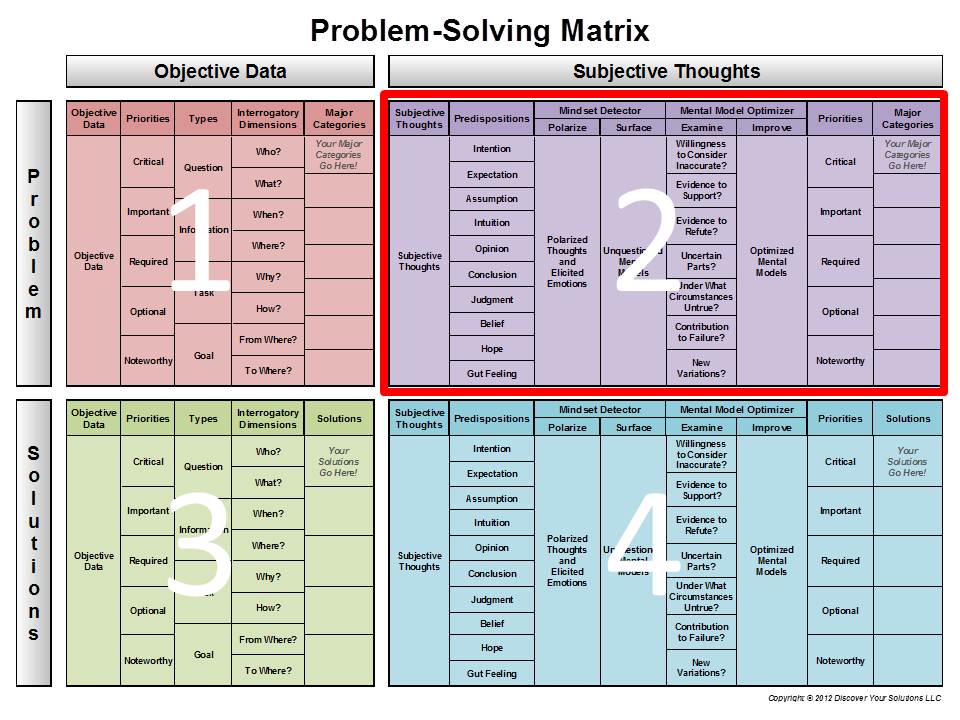
PRINTABLE: Word version of Problem-Solving Matrix.docx (Click link to download Word version).
PRINTABLE: Excel version of Problem-Solving Matrix.xlsx (Click link to download Excel version).
PRINTABLE: PDF version of Problem-Solving Matrix.pdf (Click link to download PDF version).
Predispositions

Predispositions are your personal thoughts that you're predisposed to. These include your: Intentions, Expectations, Assumptions, Intuitions, Opinions, Conclusions, Judgments, Beliefs, Hopes, and Gut Feelings.
It's important to carefully examine your predispositions that are at the crux of your problem. It's possible that one or more of your preconceived notions may be preventing you from solving your problem.
Mindset Detector

Since most of your unquestioned mental models exist below your level of awareness you need a method to bring them to the surface. To be effective, this technique needs to target mental models that are closely related to your problem. My Mindset Detector is designed to surface unquestioned mental models that are in close proximity to your predispositions about your problem.
The key to this technique is to take a predisposition that is pertinent to your problem and split it into its polar opposites. You can do this by creating an extremely positive example and an extremely negative example of your predisposition.
Next, take one of your examples of an extremely polarized predispositions and ask yourself, "How does that make me feel?" Write down your emotional feelings.
Then ask yourself, "I feel that emotion because?" Write down 'the reasons why' you feel the emotion elicited by your polarized predisposition.
These reasons why you feel emotional about your polarized predispositions are your surfaced unquestioned mental models.
Mental Model Optimizer
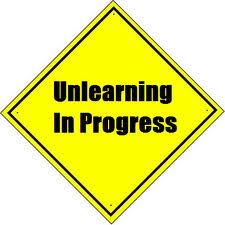
Mental models remain 'unquestioned' until they are examined and tested. The Mental Model Optimizer is designed to examine, test, and improve your unquestioned mental models.
The Mental Model Optimizer uses some insights from Unlearning Ineffective or Obsolete Technologies by William H. Starbuck.
In his abstract, Prof. Starbuck describes unlearning:
"Often, before they can learn something new, people have to unlearn what they think they already know."
Predisposition Analysis Tool
I've created a form that follows my Subjective Thoughts analytic methodology. You can find this form and instructions in my Predispositions Analysis tool. You can also check out my Problem Solving Matrix, if you're looking for complete problem solving system.
Structuring Your Subjective Thoughts is a Mechanism for Self-Determination
I think much of the time when people get stuck and can't solve their problems (especially long-term problems) it's because of their own inability to surface, examine, and improve their unquestioned mental models.
It's an incredibly liberating experience to know you have a method you can use to examine and correct your own thinking; particularly when your own thinking isn't working for you.
Having the ability to structure your Subjective Thoughts is so much more than just another problem solving tool. It's a powerful method for self-analysis, empowerment, and personal growth.
Saturday, November 30, 2013
Objective Data - Structuring a System for Analysis
There are many ways you can structure your objective data. But I know, there's only one way that you really care about. That's the one that will solve your problem.
The Cold Hard Truth
Let me share a nasty little secret with you. I'll call this bit of unsolicited advice, 'The Cold Hard Truth'. There are literally hundreds of analytical methods you can use to try to solve your problem. Odds are none of these methods, by themselves, will achieve your goal.
"How do I know which methods to use?"

Unfortunately, to know which methods to use on any given problem, you need to be an expert at using each method in many different situations. In-other-words, you need to be an expert at using all the methods to know which ones will work best. And you need to know all the methods to know what combination and sequence to use them. The cold hard truth is you need to have a PhD in Problem Solving to solve your problem using traditional methods. I know this because I had to become an expert at using each one of these methods, just to know which ones would work best for me. This learning process took years.
But there's even more to this painful story. Even after I became an expert at using all these classic problem solving tools, I found using the outputs they produced were an organizational nightmare. I was pissed. I had spent all this time and effort learning these methods, only to find out I had created an unmanageable clutter of paperwork. I tried many different ways of organizing my work over the years. Then it donned on me.
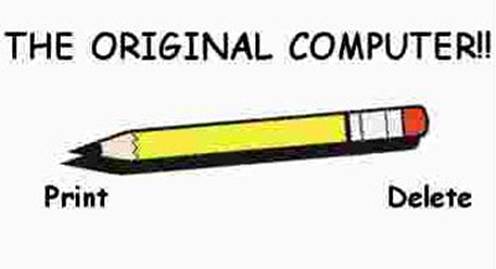
After completing each one of my problem solving projects, I had huge binders jam packed with paperwork. I seemed to me that the crux of my organizational problem was that I was using tools created in the era of pencil-and-paper and I'm now living in the digital information age.
It was time for me to move my analytical processes out of the horse and buggy days into the computer age. So, I dusted off my relational database software program and got to work.
Theoretically, I needed a software program I could superimpose on top of all my other tools, techniques, & methods that would organize their data outputs. After a few years of research and development, I decided on a conceptual design that would break my analysis into a two-by-two matrix (see diagram below). First, I separated the information about my Problem and Solutions. Next, I divided my analysis into Objective Data and Subjective Thoughts. I called my invention the Problem Solving Matrix. I've discussed some of the structural elements of the Problem Solving Matrix in my two previous blog posts.
Helpful Hint:
If you're looking at this graphic for the first time, I don't expect you to completely understand it at first glance. I know it looks complex but each part is pretty simple. The reason I've presented it here is so you can see an overview of my methodology.
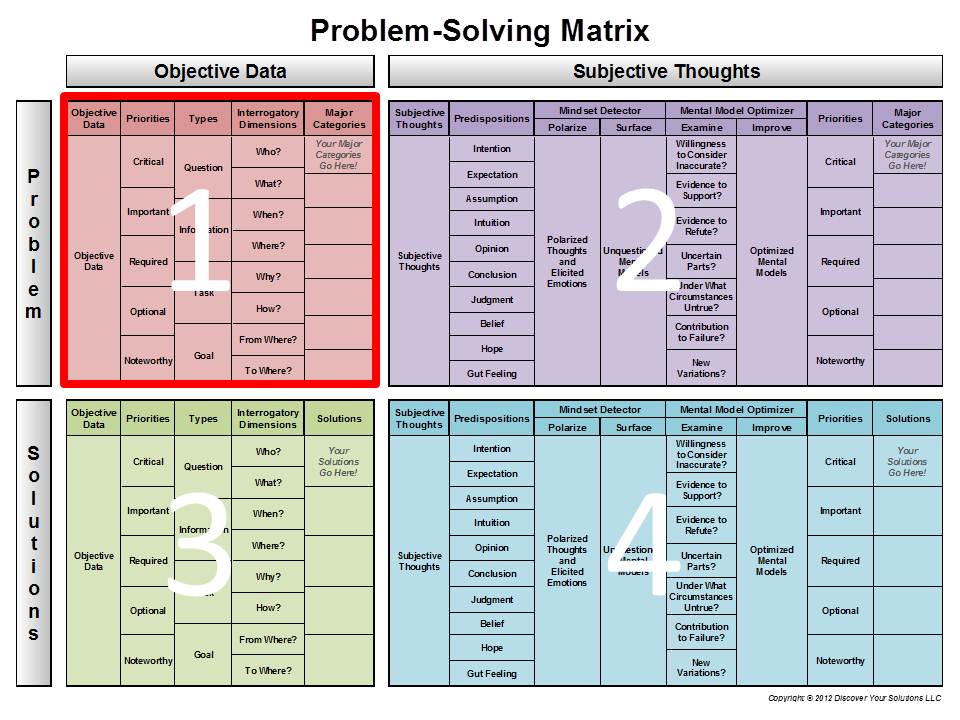
PRINTABLE: Word version of Problem-Solving Matrix.docx (Click link to download Word version).
PRINTABLE: Excel version of Problem-Solving Matrix.xlsx (Click link to download Excel version).
PRINTABLE: PDF version of Problem-Solving Matrix.pdf (Click link to download PDF version).
In this blog post, I'm going to discuss the analytical system I've devised for structuring Objective Data (boxes #1 and #3 above). It has four structuring fields: Major Categories, Interrogatory Dimensions, Type of Data, and Priority.
Major Categories
The first structural element you'll use to describe your Objective Data is what I've called Major Categories. The idea is pretty simple. You just break your problem down into its major component parts. Your goal here is to identify all of your Major Categories.

Major Categories should be:
- Clearly defined,
- Mutually exclusive, and
- Collectively exhaustive.
Your Major Categories are the foundation that the rest of your problem-solving structure will be built upon. For complex problems, you may have multiple levels of sub-categories that form a hierarchical structure of your problem.
For help to decompose your problem into its major factors, use our Major Categories tool in our Toolkit section.
Defining your Major Categories may seem like an easy task but you need to take your time here and think this all the way through. Keep in mind that you must have a place to put all of your data (i.e. no pieces of data can be left out). Please also remember that your Major Categories will determine the scope of your analysis.

Interrogatory Dimensions
'Interrogatory Dimensions' is a fancy way of saying, describe your data by its root question.
Asking the right questions has always been a good way to solve problems. Since the beginning of human development, our curiosity and ability to find answers to questions has been a hallmark of the species. With the advent of language we developed words to describe different types of questions to each other and to ourselves.
Many of you may already be familiar with the age-old journalist's list of: Who, What, When, Where, Why, and How. These are called interrogatory words.
Unfortunately, I found that I could not describe all of my objective data with just these six interrogatory words. The data I had trouble defining all shared a common trait. They were related to the time continuum. It turned out that the interrogatory word when was fine for describing data related to the present but it wasn't good at defining some data related to my problem's past or my problem's future.
So, I went back in time and researched the root words related to questioning. I found two no longer used archaic words 'whence' and 'whither' that were just what I was looking for. Next, I needed to find their modern usages. It turned out that the modern usage for whence is From Where and for whither is To Where.
From Where describes the type of questioning needed to analyze the origins of your problem, its sources, and its root causes.
To Where describes the type of questioning needed to analyze your direction, outcomes, and goals.
Interrogatory Dimensions are important to your analysis because they make sure all of your Major Categories have been completely questioned. In essence, it becomes a de facto checklist for completeness. Interrogatory Dimensions also provides another structural element that you can use to mirror between your problem and your solutions.
Types of Data
I divided Objective Data into four data types: key questions, information, tasks, and goals.

Key Questions - Asking questions is one of the most important techniques you can use to explore the different dimensions of your problem. It just makes sense that finding the right questions will give you a better understanding of your problem and get you closer to the answers that will eventually solve your problem. As you go through the problem-solving process keep track of your key questions. To help you get started, I've developed several lists of generic questions: Who, What, When, Where, Why, How, From Where, To Where, and the Phoenix Checklist. Review the lists of generic questions and pick out the ones that you consider to be key questions for your situation. Of course, the questions you think of on your own could be the best questions of all.
Information - This is where most of your data will go. It collects the answers to your questions and it's a catch all for items that don't fit into any of the other data types.
Tasks - Collecting and organizing your tasks can be a big job. I gather all of my tasks together under this data type. If I have a large amount of tasks for many other people I usually use a separate Task Manager program. There are many of them available on the internet.
Goals - Identifying your goals is an important part of problem solving. I created a separate data type just for goals. If you need help with your goals, check out my Goals tool in the Toolkit.
Priority
To help you prioritize your Objective Data I created a Priority field that you can use to sort your data.
It's a simple system:
1. Critical
2. Important
3. Required
4. Optional
5. Noteworthy
Structuring Your Objective Data Can Save Your Sanity
The analytical system I've created for structuring your Objective Data will help you optimize your ability to manage your data. It will make your data more functional (ex. sorting and filtering). It will also give you the unique capability of mapping your data between your problem and your solutions.
Having a logical, well thought out system to manage your problem solving data may be the difference between solving your problem and going crazy. That's what structuring does. It establishes order; order instead of chaos.
Tuesday, November 12, 2013
Structure - Objective Data vs. Subjective Thoughts
Structuring is the most important concept in problem solving. As I discussed in my previous blog post, structuring helps you better understand your situation by creating representations of your problem and your potential solutions.
"What's the highest level of my structure?"
At its very highest level, I've divided the structure into two halves - Objective Data and Subjective Thoughts.
Now, I've got to admit to you that clarifying the language of this initial branching of the problem solving structure was a difficult task for me. I've seen many ways to describe the division of ones thinking into two parts:

- Left Brain vs. Right Brain
- Logical vs. Emotional
- Data vs. Personal Thoughts
- Objective vs. Subjective
- External Thinking vs. Internal Thinking
- System 2 vs. System 1
- Head vs. Heart
Since I needed to standardize my language, I decided on the phrases, 'Objective Data' and 'Subjective Thoughts'. These terms may seem general, vague, or oversimplified but I felt they were closest to the concept I was defining. My main consideration for bifurcating the structure at this level was to separate out 'predispositions'. This was really important to me because one of the primary goals of my methodology was to examine unquestioned mental models. Specifically, unquestioned mental models that were used to support predispositions at the crux of the problem.
The key point here for you is that your analysis should be divided into two parts - objective data and subjective thoughts.
'Objective Data' as the phrase suggests refers to the object. 'Subjective Thoughts' pertains to you, the subject. So, your objective data are external objects (i.e. who, what, when, where, why, how, from where, & to where) and your subjective thoughts are your internal thoughts (i.e. expectations, intentions, assumptions, intuitions, opinions, conclusions, judgments, beliefs, hopes, & gut feelings). These are your predispositions.
Model of Analytic Processes for Objective Data
Now, take a look at my Model of Analytic Processes for Objective Data. As you can see in the conceptual diagram below, developing the structure of your objective data over time can be a complex process. Fortunately, it's an natural intuitive process.
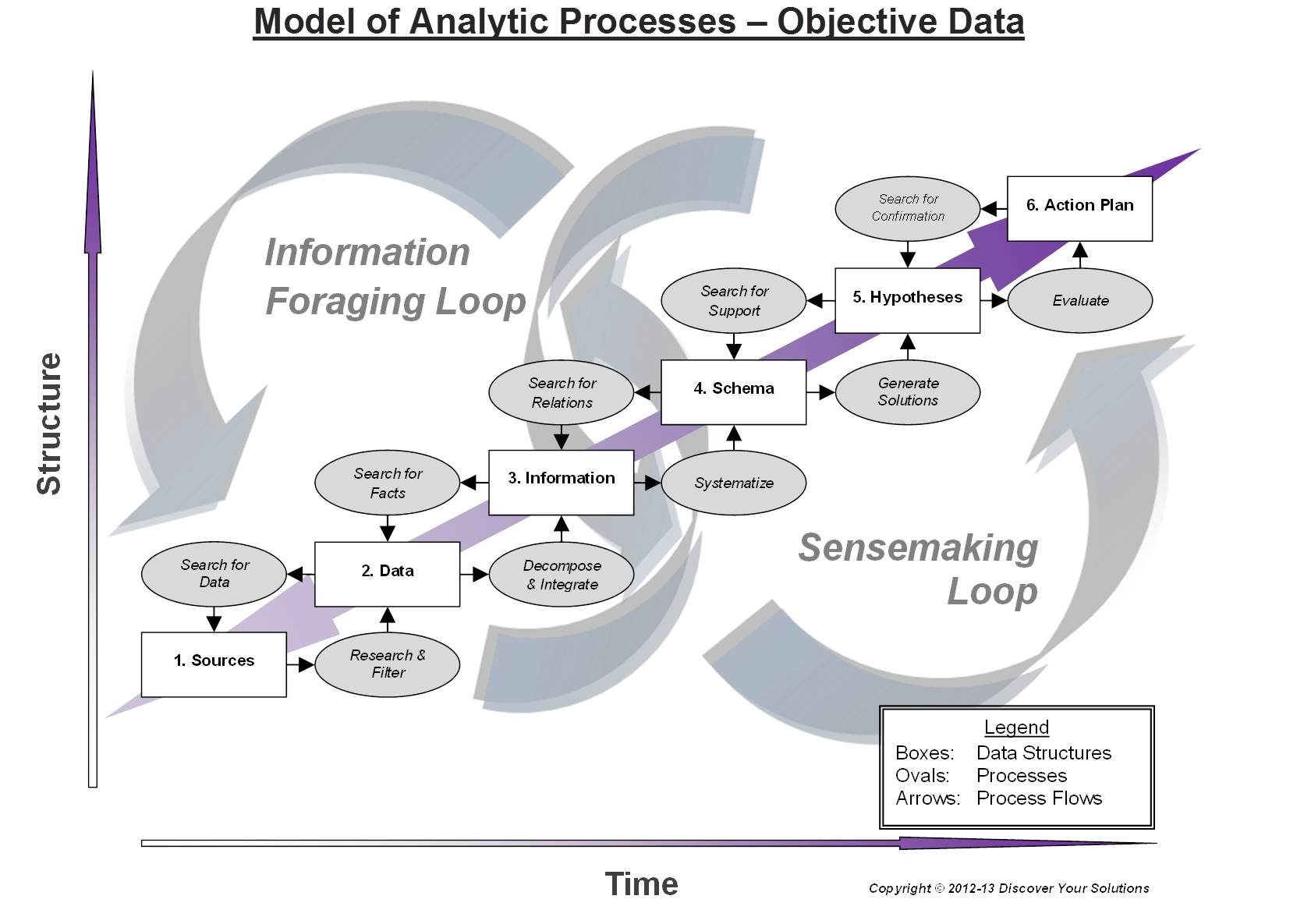
PRINTABLE: Word version of Model of Analytic Processes - Objective Data.docx (Click link to download Word version).
PRINTABLE: PDF version of Model of Analytic Processes - Objective Data.pdf (Click link to download PDF version).
For more information about the Model of Analytic Processes for Objective Data, go to Detailed Information.
Model of Analytic Processes for Subjective Thoughts
My Model of Analytic Processes for Subjective Thoughts below is a conceptual diagram that shows how analytical processes develop the structure of your mental models during problem solving. This process is used to examine your own personal thoughts for any flaws in your thinking that could be blocking you from solving your problem.
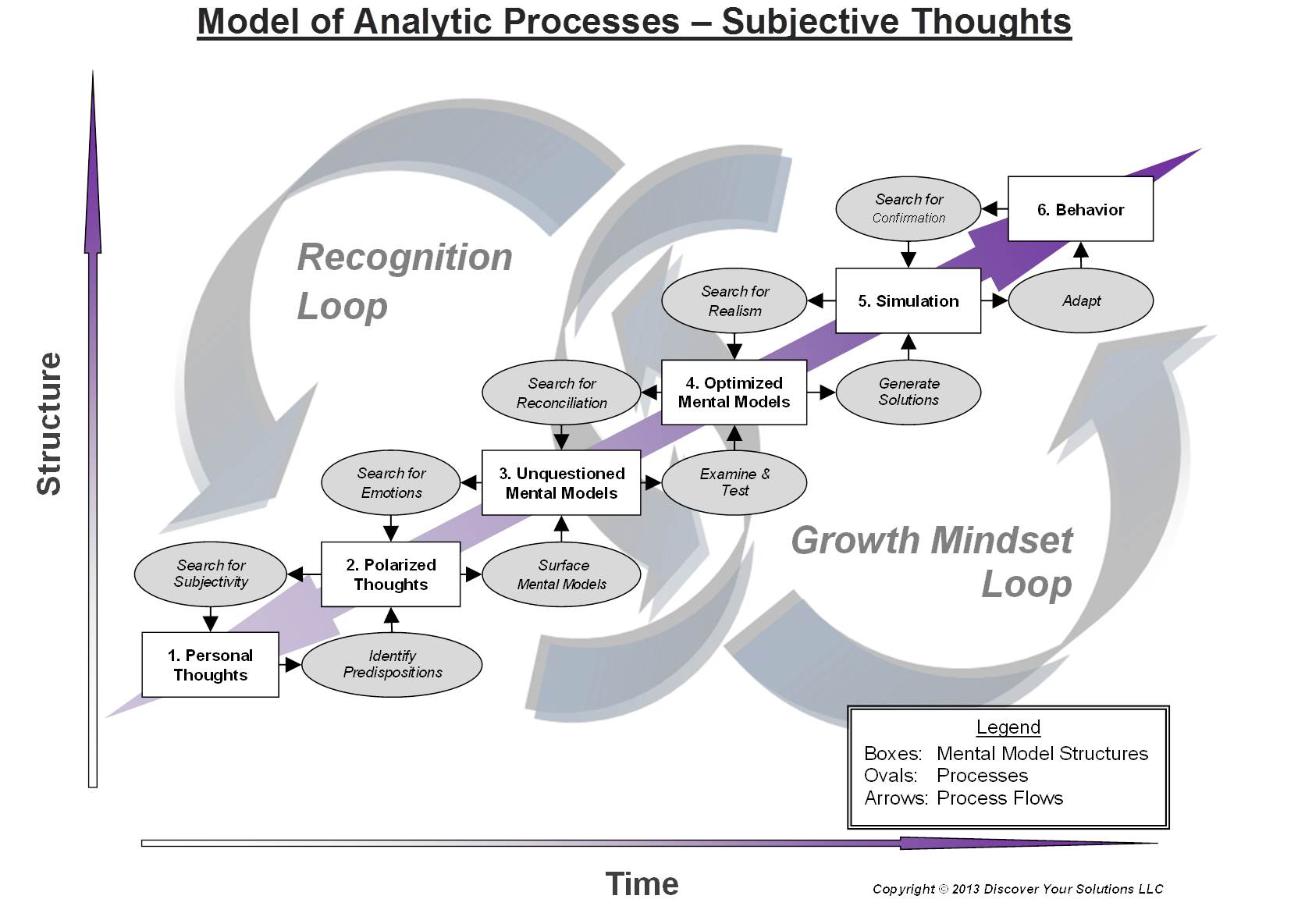
PRINTABLE: Word version of Model of Analytic Processes - Subjective Thoughts.docx (Click link to download Word version).
PRINTABLE: PDF version of Model of Analytic Processes - Subjective Thoughts.pdf (Click link to download PDF version).
For more information about the Model of Analytic Processes for Subjective Thoughts, go to Detailed Information.
"So what does this mean to me?"
This means your structuring, at the highest level, will be aligned with the most basic way your brain operates. And that means that the specific structure of your representation of your problem will also be aligned, making your problem easier to understand and easier to solve.
Wednesday, October 30, 2013
Problem Structure vs. Solution Structure
Structuring is at the heart of most problem solving methods. Structuring your problem is probably the most important activity you'll perform in the problem solving process.
The purpose of these structuring activities is to help you create a representation of your problem. This model of your problem becomes the framework that you build your knowledge upon.
In a group setting, structuring allows members to share a similar mental model of the problem. This shared representation of the problem is vital to maximizing everyone's capacity throughout the problem solving process.

"How do I create the most effective structure for my problem?"
I think the best way to create your structure is to use my structured analytical techniques. Yeah, I admit I'm biased towards this approach. But keep in mind, I've done a lot of problem-solving during my 20+ years in the consulting business. I've analyzed problems at 100+ companies and have successfully created 1,000+ solutions. Believe me when I tell you that I've been through the school of hard knocks working on some these problems. And there's been some real pain along the way. I'd really like to save you from experiencing the same, so I created this website to provide you with all the best problem solving tools and techniques.

Most problem solving approaches begin with analyzing the problem. Typically you start by stating your problem in a clear and concise written statement. Next, you decompose your problem into its component parts. Once you've identified the all parts of your problem you're able to manipulate your data using routine functions, such as, sorting, filtering, and prioritizing. Conventional wisdom also suggests you may want to analyze your data by searching for relationships, looking for comparisons, and creating visual representations.
In my proprietary programs, called Solvers, I've strived to demystify the traditional structuring process by creating best practices. I've accomplished this by standardizing the structuring process and basically turning it into a mechanical process.
One of my innovative methodologies is to split the analytical process into two separate branches: objective data and subjective thoughts. Objective data includes your factual and unbiased data (in-other-words, this data is not influenced by your personal feelings, interpretations, or biases). Conversely, your subjective thoughts are your own personal thoughts and feelings.
Your objective data is grouped into major categories. Next, you divide it into interrogatory dimensions (i.e. who, what, when, where, why, how, from where, & to where). It may also be helpful to further classify your data by data type, such as, key questions, information, tasks, and goals.
Your subjective thoughts should also be grouped by the same major categories discussed above. Next, your subjective thoughts are classified by type. Examples of subjective thought types are: expectations, intentions, assumptions, intuitions, opinions, conclusions, judgments, beliefs, hopes, & gut feelings. I generally refer to these types of personal thoughts as predispositions.

One of the most unique and powerful features of my approach is that it superimposes the structure of your problem on to your solutions. This is a really important concept because certain aspects of your solution will mirror specific characteristics of your problem. Within the highly structured environment of my Solvers, you can more effectively evaluate the essential structural elements and critical data relationships between your problem and your solutions.
Friday, October 11, 2013
Problem Solving - A Plan for Failure
Solving a really difficult problem can be an exhilarating experience. The sense of accomplishment can be profound but there are usually a few failed attempts on the road to total glorious victory.
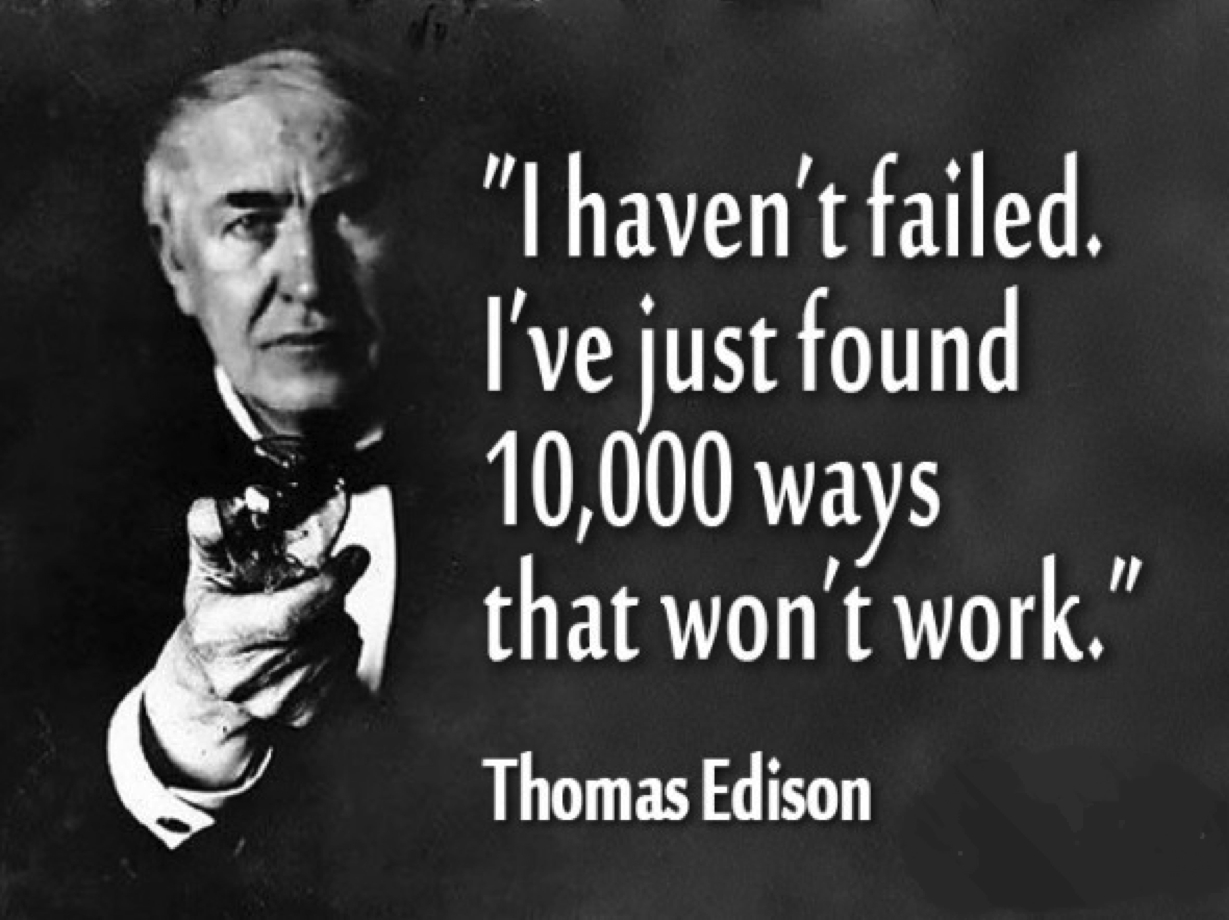
In many ways, problem solving is a plan for failure. This concept may seem counterintuitive at first, so let me elaborate. By definition, a really difficult problem is not going to be easy to solve. Your first few attempts will most likely fail. So, your ultimate success may depend on how fast you can learn from your failures.
I encourage you to plan for failure. Don't be surprised. Don't get discouraged. It's just a normal part of the problem solving process. You should view these failures as golden opportunities that may provide you with the help you need to find a successful solution.
Common Reasons for Failure
The bullet points below are a few of the common reasons why people fail to solve their problems. I've added some of my own commentary beneath each one of them.
• You lack information.
You need to add more or better information.
You'll probably never have 100% of the information you desire. So the issue becomes, what information is necessary to solve your problem. At a bare minimum, you need to have a clear understanding of your situation. You can do this by identifying the best sources of information for your issue and develop that information by using our structured problem solving techniques.
• You have too much information.
You need to improve your ability to interpret your data.

Information overload has become more prevalent as our society races forward with technology. There are a couple of ways this can be troublesome in problem solving. First, there's paralysis by analysis. This is where you find your analytical processing abilities simply overwhelmed by a tsunami of data. This is not good but it's usually pretty obvious when it's happening. Then there's another far more subtle aspect of 'big data' you should be aware of. Psychological experiments have been conducted on the relationships between the amount of information available to experts, the accuracy of judgments based on this information, and the expert's confidence level in the accuracy of these judgments. Unfortunately, these experiments have shown us that our confidence level tends to go up with more data but our accuracy tends to go down.
• You have some bad information.
You need to validate your data.
Sometimes your information is good. Sometimes your information is not so good. The important thing, is to understand the quality of your information. You may need a method to check your information to determine it's quality, especially your mission critical data. Validating your data may have some subtleties, too. There's a lot of disinformation out there, so always try to validate your critical data or at the very least try to verify the degree of uncertainty you're dealing with.
• Your regular methods aren't working on this particular problem.
Try using different methods.
There are many common ways people go about solving their problems. However, when your regular methods don't work you can get stuck. If you're stuck, we suggest you try using some new methods. We offer over 100 free problem solving tools, techniques, and methods in our Toolkit. These are the best ones we could find in books and on the internet.
• You're not familiar with the methods needed to solve your problem.
Try learning new methods.
Our tools are written in a simple step-by-step style that make them easy to use. First, take a look at what tools we've made available to you. Second, determine which ones you think can help you the most. Finally, just roll up your sleeves and get to work. You may also want to check out our Solvers (all-in-one problem solving methods).
• You don't have enough time.
You may need to manage your time more efficiently or determine if your time constraints are real or arbitrary.
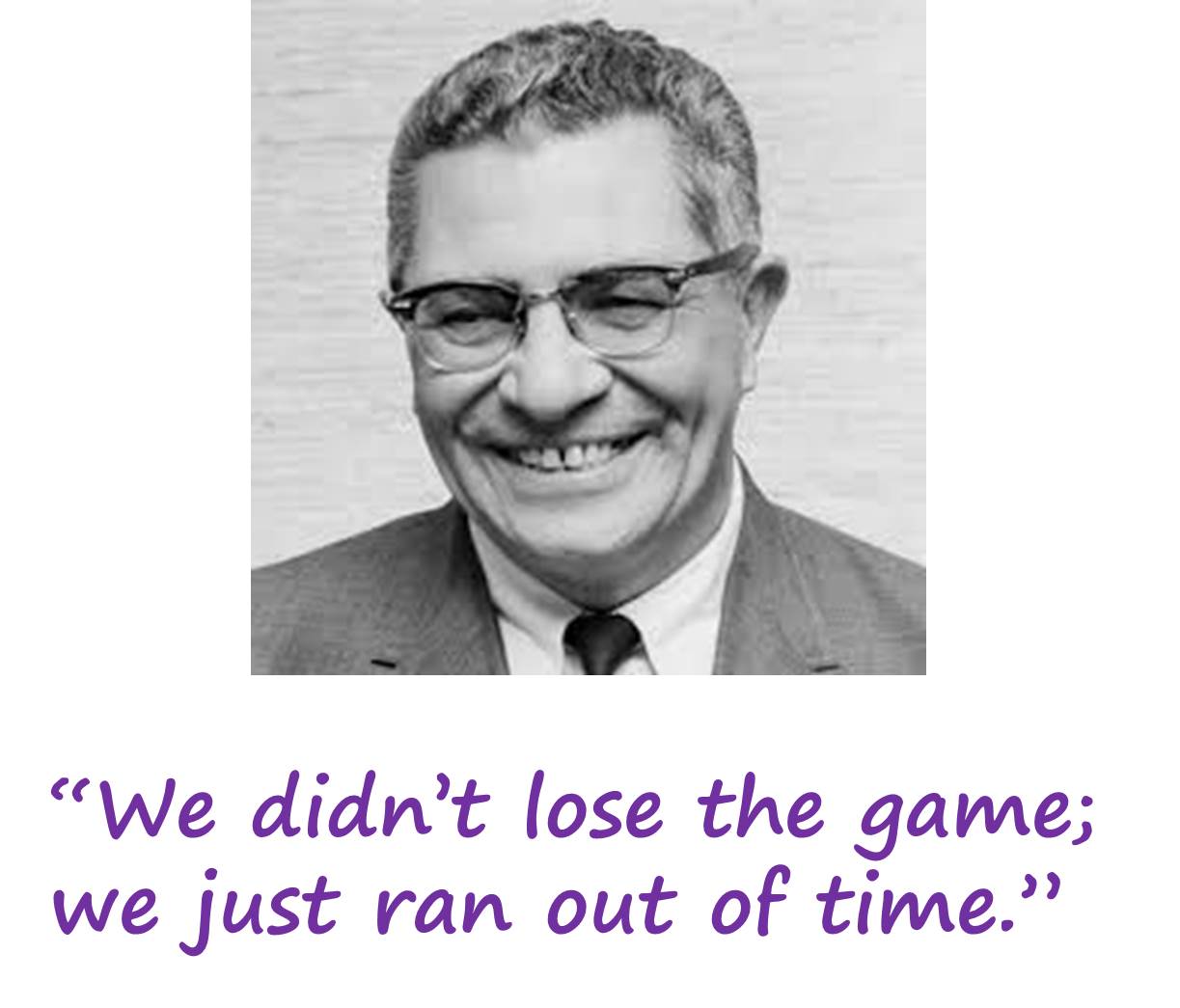
Sometimes you just don't have enough time, period. For example, your boss tells you to spare no expense but you must have a cure for the common cold by the end of the day. It ain't happening ... and there's nothing you can do about it. There's a physical time constraint that makes this impossible. Now, let's say your boss gives you an unlimited budget and 50 years to find a cure for the common cold. See how important changing the time element can be? I think time is one of the most important aspects in problem solving. It's so obvious, we sometimes tend to overlook it. With unlimited amounts of time almost anything seems possible. When time is short your options may be very limited.
• You're unable to properly identify the root cause of your problem.
Use our root cause analysis tools.
Failing to identify the root cause of a problem is a common reason for not being able to solve it. You need to make sure you're solving the real problem. Not the symptoms of your problem. Not the problem someone else thinks you have. Not the problem you already have a solution for. If you don't know the root cause of your problem, you may be solving the wrong problem. Folks, I learned this one the hard way. Don't make the same mistake I did.
• You're seeking a perfect solution.
You need to change your expectations.
Expectations can play a huge role in problem solving. Your preconceptions can make you or break you when it comes to problem solving. One of the four cornerstones in our problem solving model is predispositions. Searching for a perfect solution implies that you already have a preconceived notion that a perfect answer exists. You'd be much better off to start with an open mind, use our structured problem solving approach, and see what you can learn about finding the best solution.
• You're relying on outmoded mental models.
Surface, examine, and improve the unquestioned mental models at the heart of your problem.

Unquestioned mental models can certainly lead to problems given the rapidly changing, highly complex, and uncertain world we live in. If you understand that all of your analysis is based on your potentially fallible mental models, then you need an approach that gives you the greatest amount of mental agility and flexibility. Ultimately, it stands to reason that your success or failure to solve your problem may rest with your ability and willingness to question your own thinking.
• You're subject to a psychological pitfall.
Use structured problem solving techniques to overcome pitfalls.
There are many psychological pitfalls that can keep you from solving your problems. There are way too many of them to discuss in this blog post. Take a quick look at these Wikipedia lists of common pitfalls: cognitive bias, fallacies, cognitive distortions, memory bias, etc. See what you're up against? There are literally hundreds of ways your thinking can be derailed by psychological pitfalls. If you're interested in this subject, check out Richards J. Heuer's authoritative book titled: Psychology of Intelligence Analysis. It's a fabulous book. It will forever change the way you look at the world.
I ♥ Failure

Most of us have been socialized to think that failing at anything sucks. It's something you should avoid. You don't want to be tainted by failure; it's a label that might stick to you.
Not many of us wake up in the morning thinking, "Today is going to be a great day to fail!". However, you may be surprised to learn that people who have this mindset are quite successful. These people are fearless when it comes to failure. They view it as an opportunity for growth. Failure is just a bump, on the road to success.
Failure is always going to be a part of solving really difficult problems. You'd be wise have your own philosophy for dealing with failure, before you encounter it further up the road.
Sunday, September 29, 2013
I think most people have a pretty good understanding of the importance of problem solving in their lives. The ability to solve problems is woven deeply into the fabric of our very existence. However, a conceptual understanding of problem solving can be a little harder to get your arms around.

“What is problem solving?”
If you asked 100 people to define problem solving you may get 100 different answers. That’s because the definition of problem solving seems to be dependent on the knowledge domain that it's used.
Case in point, if you asked a doctor to define problem solving, the answer may have something to do with a diagnosis. If you asked a psychologist, the answer may have something to do with the cognitive processes of the mind. Ask a math teacher and it may have something to do with the steps in a formal proof.
Since many definitions of problem solving are influenced by the fields in which they are used, a natural question is: "Are there any general definitions of problem solving?" The answer is yes. Unfortunately, these definitions don't add much to our overall understanding of problem solving.
For example, take Webster's Dictionary definition of problem solving: "Process involved in finding a solution to a problem." Most of these general definitions of problem solving have three elements - a problem, a solution, and a process. The 'problem' and 'solution' are self-evident, so that leaves us with the ambiguous and undefined term 'process'.

This mysterious process appears to be the key to clarifying the definition problem solving. As I pointed out in my earlier examples, the process is usually bounded by the field of knowledge where the problem solving is being done. What we need is an unbounded definition that is not overly simplistic. We need a universal definition of problem solving that can be applied to any domain of knowledge. I really felt that I needed a universal definition as a prerequisite because people from all walks of life come to my web site to solve their problems.
At it's most fundamental level, I think a universal definition of problem solving needs to include both the external (real world) and internal (cognitive) activities that are going on when you're solving a problem.
The external activities are the tactical and strategic - tools, techniques, & methods you employ to solve your problem. These are the external analytic processes you use to analyze your problem, create solutions, and evaluate your alternatives.
The internal activities are based on your mental models. Mental models are your internal representations of reality. These internal thought processes help you interpret the world around you.
My universal definition:
"Problem solving is a continuous process of externalizing internal thought processes by using analytic methodologies, then internalizing the external analysis by updating mental models."
The following diagram is a visualization of the problem solving process.

PRINTABLE: Word version of Problem Solving Model.docx (Click link to download Word version).
PRINTABLE: PDF version of Problem Solving Model.pdf (Click link to download PDF version).
This is a looping process that provides you with continuous feedback. You use tools to learn more about your problem. Then you use what you've learned to optimize your mental models. Improving your interpretations of your situation should offer you more opportunities for continued learning from the additional use of external analytic methodologies. This process of learning and updating continues until you eventually solve your problem.
Saturday, September 14, 2013
Typical Ways to Solve Problems

Life is full of challenges. If there’s one thing you can count on in this life, it’s that you’ll have to deal with a few problems now and then.
Our problems come in all shapes and sizes. Some problems can be a little irritating, while others can block out the sun. Some can be quite predictable, while others can come out of nowhere and blindside you. Some problems can drive you completely nuts, while others can inspire you to new heights that you can’t even imagine. But one thing is for sure, we all have a few obstacles in our path.
Since encountering problems is just part of our human experience, an important question for each of us is:
“How do I solve my problems?”
There are several typical ways people go about solving their problems.
Most people begin by using the same methods that have worked for them in the past. It just makes sense to repeat actions that were successful in similar situations. This way seems to work pretty good for most folks, especially as we get older and wiser. When you use this method, you’re generally using analogies.

Another common way to solve problems is to find someone else who has already solved your problem. You could ask a family member or friend for advice. This method works well if you know someone who has had the same problem, especially someone who has found a solution you like. For some problems, you can even ask an expert in the field, such as, a doctor or a lawyer.

Another way is to teach yourself how to solve your problem. Using this method you’d research a specific topic, learn as much as you can, and evaluate the alternatives you’ve found.
The methods listed above are the typical choices most people try when they attempt to solve their problems.
But many people come to my web site with a bigger question.
“What do I do when I’ve exhausted all of my regular methods for solving my problem?”
Do you keep trying to do the same things over-and-over again expecting a different result? That’s crazy.
Do you just give up? Do you live with your problem and try to adjust to some kind of new normal? Or worse, do you live in complete denial? Unfortunately, that’s exactly what lots of people do. As a man much wiser than I once said, “Don’t give up ... don’t ever give up!” - Jimmy Valvano.

I don’t want you to give up, either. That's the main reason I created the Discover Your Solutions web site and put together all these problem-solving tools. To give you another chance … to give you alternative methods to solve your problems … to give you hope.
Many of the alternatives that I’ve presented in this web site are structured analytic methodologies. That's a fancy way of saying, they’re structured approaches you can use to analyze your problem and create solutions.
I think one of the greatest things about structured problem-solving is that it’s a skill that you can use for the rest of your life. In-other-words, it’s a skill you can apply to almost any problem you’ll encounter in the future. As the saying goes …
“Give a man a fish and you feed him for a day; teach a man to fish and you feed him for a lifetime.” - ancient Chinese
So now it’s up to you. Do you quit? Or do you take advantage of the problem-solving opportunities I’ve presented here and attack your problem?
Tuesday, August 27, 2013

For most people, having their problems disappear would be considered a good thing. Well, probably a really great thing. Woo Hoo! Less stress ... less worrying ... less chaos. But I think there's so much more to problem-solving than just getting rid of those irritating negative situations.
Being able to solve your problems is empowering. It infuses you with the confidence you need in today's highly complex, rapidly changing, and uncertain world. This confidence gives you enthusiasm for taking on new challenges.
Problem-solving makes you feel more secure. You can view your ability to solve problems as a sort of security blanket. In essence, it's a way to help make yourself bullet proof in a sometimes cruel world.
I believe it also gives you freedom. Freedom through self-determination. Freedom through self-expression. When you're able to solve your problems, you're able to move freely out of your comfort zone and expand your horizons.
There's most certainly a self-improvement aspect to problem-solving, too. When you have successfully created a solution, you have direct evidence that you're a growing, evolving person. It's not some theory about how you can improve yourself. It's not some faddish, free good psycho-babble. It's an incontrovertible fact. You solved your problem and you have improved yourself.
Problem-solving can also give you hope. Hope for a more optimistic future. Hope that you can attain your goals and reach for your dreams.
Being able to solve your problems can make you happier. When you solve a problem you also eliminate the stress, anxiety, frustration, and feelings of inadequacy that may come with it.
Yeah, it's nice when you solve a problem and get rid of those nasty irritating negative issues. Good riddance! But remember, at the same time you've been solving your problem, you've also been building up some really beneficial personal traits.
I think the most profound benefit of problem-solving is that it makes you a better person.
